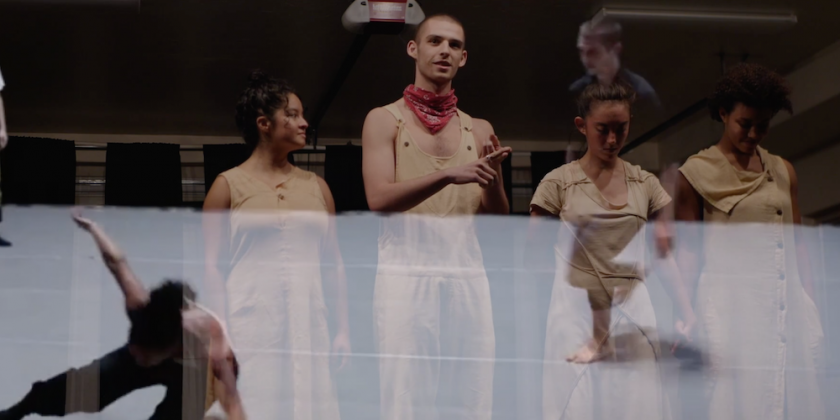Jamal Jackson Dance Company

As the Company Prepares for “The People Vs.” at The Actors Fund Arts Center
The Actors Fund Arts Center
160 Schermerhorn Street
Brooklyn, NY 11201
Thursday, April 23 through Sunday, April 26 at 8 p.m.
For tickets, please click here.
Choreography by Jamal Jackson
Performance by Adrian Jevicki, Lynnette Freeman, Jacinthe Burton, Liz Beres, Rebecca Greenbaum, Jasmine Domfort, and Dana Thomas
Music by Frank Malloy IV
Costumes by Coleen Scott
Artworks by Leo Tecosky and Téa Chai
It was the trial of the century. Twenty years later, the images are still burned into our collective conscience: the white Bronco in a low speed chase; Johnnie Cochran's quote-worthy remarks (“if it doesn’t fit, you must acquit”); Kato Kaelin’s long, blond locks and rambling testimony explaining what, exactly, happened that fateful night. For months, the nation was gripped by the murders of Nicole Brown Simpson and Ronald Goldman — murders for which the former football luminary, and well-known media personality, O.J. Simpson, was ultimately arrested and charged.
In Jamal Jackson's new work The People Vs., he poses the question: Was justice served? Using a lively brew of text, movement, music, and imagery, he aims to craft a work that reexamines the O.J. Simpson trial from a fresh angle to discover what relevancy can be drawn from it. Jackson elaborates, "Before 9/11, this was the defining moment for my generation. I remember where I was when the verdict came in." The trial’s impact on America was exacerbated by the three-ring news circus, which anticipated the media saturation now surrounding hot-button events and our current fascination with celebrities. Jackson emphasizes, "It was reality TV before there was reality TV."

The O.J. Simpson trial burst onto the scene when racial tensions were pitched, the savage beating of Rodney King by police officers looming large in the minds of many Americans. Simpson, a black man as well as a handsome, wealthy movie star, went into the courtroom, as Jackson puts it, “guilty until proven innocent.” When the not guilty verdict came in, opinions between blacks and whites, as demonstrated by polls and news reports, diverged wildly. Many whites felt the trial made a mockery of the American justice system while most blacks perceived that, for once, the jury had given a black man a fair shake.
The People Vs. features a barrage of stimulation designed to replicate the experience of a jury member — a non-expert who must wade through an onslaught of unfamiliar information and then make a weighty, moral decision. The quick-paced movement combines the punchy rhythms of West African, Jackson’s original field of study, with the level changes and athletic floor work of modern dance. From time to time, cabrioles (a ballet step in which the dancer jumps, beats his or her legs, and then lands with legs apart) jut high into the air. Original text, written by Jackson, Adrian Jevicki, and Lynnette Freeman, alternates with snippets pulled from the courtroom transcripts. Two performers act as lawyers, representing both the defense and prosecution. There will be artworks by Leo Tecosky and Téa Chai, and Frank Malloy IV will provide the original score.

Jackson isn’t trying to guide audiences toward a specific decision. Instead, he wants everyone to come to his or her own conclusions. As such, he has created variables involving audience participation to reframe the traditional theater experience. During the rehearsal I attended at Union Street Dance in Brooklyn, I played the part of Brenda Vemich, a Bloomingdales’ buyer, during a scene in which she admits to the court that she cannot identify the glove size or color based on a receipt alone. In another vignette, corrupt police officers shoot people, and using show-goers, the performers construct a pile of bodies. Jackson wants his audiences to reflect, “Are these people more valuable once they have been killed?” How about once they’re in the space versus when they’re in their seats?”
The O.J. Simpson trial had an influence beyond discussions about race; it spurred the importance of DNA evidence in legal proceedings. As a result, the Innocence Project, the brainchild of Barry Scheck and Peter Neufeld, two lawyers who served on Simpson’s legal team, took off. Since its inception in 1992, the Innocence Project has helped exculpate over 200 people wrongly accused of a crime through the introduction of DNA evidence, thus placing hard proof as the cornerstone for guilt.
Jackson researched the trial extensively, reading transcripts and watching old footage. In The People Vs., he pulls from the trove of familiar pictures and then manipulates them. “I want every section to be presented as evidence,” he explains. In one scene, dancers claw and wave in a series of brisk gesticulations before struggling to shove their hands into a pair of too tight gloves. In another, Plato’s “The Republic” is read in the manner of a Southern Baptist preacher. By using the real and the poetic, the evidence can be interpreted and reinterpreted in a variety of ways.

Jackson elects to use mostly female dancers although many of the important names associated with the O.J. Simpson case were men. He indicates that while “a lot of the movement is very masculine, I like the way it looks on a female body.” Jackson continues, “I don’t want gender to play a role in these characters.”
While much has changed in 20 years, there is still contempt and suspicion of the justice system, and the impression that blacks are treated differently than whites lingers. The People Vs. hopes to converse, through the piece and in post-show talkbacks, about the lasting impact of the O.J. Simpson trial, both then and now.
How will you find the defendant?















